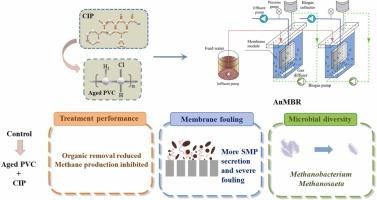Effects of microplastics accumulation and antibiotics contamination in anaerobic membrane bioreactors for municipal wastewater treatment
IF 12.2
1区 环境科学与生态学
Q1 ENGINEERING, ENVIRONMENTAL
引用次数: 0
Abstract
Municipal wastewater treatment plants are the main collection points for plastics and antibiotics. Anaerobic membrane bioreactor (AnMBR) is one the most potential municipal wastewater treatment technologies. This study evaluated the impact of microplastic (aged polyvinyl chloride, aged PVC, 1.5 g/L), antibiotics (ciprofloxacin, CIP, 100 μg/L) and their interaction effect on AnMBR treatment performance and membrane fouling. Results showed that the inhibition of CIP on AnMBR organic removal and methane production was intensified, owing to the CIP adsorption on aged PVC. The enzyme activities of electron transport (ETS), adenosine triphosphate (ATP) and F420 were also significantly restrained by 47~52% with combined exposure. The combined effects also significantly aggravated the membrane fouling of AnMBR, which shorted the membrane operational period by half due to more soluble microbial products (SMP) secretion. The microbial diversity analyses indicated that aged PVC and CIP addition can accumulate some main anaerobic fermentation bacteria but inhibit the archaea. The abundance of related enzyme in the acetoclastic and hydrogenotrophic methanogenesis decreased with the sole aged PVC and CIP addition and severely inhibited with their combine effect. The absolute abundance mcrA significantly reduced by 92% with combined exposure, validating the negative impact on methanogenic activity. These findings provide valuable insight into the AnMBR implementation in complex wastewater treatment.

求助全文
约1分钟内获得全文
求助全文
来源期刊

Journal of Hazardous Materials
工程技术-工程:环境
CiteScore
25.40
自引率
5.90%
发文量
3059
审稿时长
58 days
期刊介绍:
The Journal of Hazardous Materials serves as a global platform for promoting cutting-edge research in the field of Environmental Science and Engineering. Our publication features a wide range of articles, including full-length research papers, review articles, and perspectives, with the aim of enhancing our understanding of the dangers and risks associated with various materials concerning public health and the environment. It is important to note that the term "environmental contaminants" refers specifically to substances that pose hazardous effects through contamination, while excluding those that do not have such impacts on the environment or human health. Moreover, we emphasize the distinction between wastes and hazardous materials in order to provide further clarity on the scope of the journal. We have a keen interest in exploring specific compounds and microbial agents that have adverse effects on the environment.
 求助内容:
求助内容: 应助结果提醒方式:
应助结果提醒方式:


